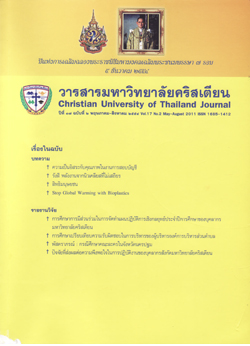ความเป็นอิสระกับคุณภาพในงานการสอบบัญชี
บทคัดย่อ
ภายหลังการเกิดวิกฤติเศรษฐกิจทั่วโลกใน ค.ศ.1997 ส่งผลให้กิจการต่างๆหันมาให้ความสนใจแนวคิดการกำกับดูแลกิจการที่ดี (Corporate governance) โดยมุ่งเน้นให้ความสำคัญกับการมีผู้สอบบัญชี 3 ระดับ คือ 1) ผู้สอบบัญชีภายนอก (External auditor) 2) ผู้ตรวจสอบภายใน (Internal auditor) และ 3) คณะกรรมการตรวจสอบ (Audit committee) ที่มีประสิทธิภาพ โดยเชื่อว่าบริษัทต่างๆ ที่ประสบภาวการณ์ล้มละลายจนทำให้มีผู้ได้รับความเสียหายจำนวนมากนั้น เป็นผลมาจากการบริหารงานที่ขาดประสิทธิภาพ มีการทุจริตและไม่มีความโปร่งใสในการดำเนินงาน ด้วยเหตุนี้ธุรกิจต่างๆจึงให้ความสนใจศึกษาวิจัยบทบาทหน้าที่และงานการสอบบัญชีของผู้สอบบัญชีในระดับต่างๆ เพื่อศึกษากลยุทธ์ที่หลากหลายที่จะนำมาปรับใช้ในการควบคุมการบริหารงานของตนให้มีประสิทธิภาพ มีความโปร่งใส และสามารถส่งสัญญาณเตือนภัยให้ผู้บริหารทราบล่วงหน้าเกี่ยวกับฐานะการเงินและสภาพการดำเนินงานที่จะเกิดขึ้นในอนาคต
บทความนี้มีวัตถุประสงค์เพื่อนำเสนองานวิจัยเกี่ยวกับความเป็นอิสระกับคุณภาพในงานการสอบบัญชี ได้แก่ การกำหนดให้หมุนเวียนผู้สอบบัญชี (Mandatory auditor rotation) การหมุนเวียนผู้สอบบัญชีต่างสำนักงาน (Auditor rotation in difference office) ผลกระทบจากมาตรการสับเปลี่ยนผู้สอบบัญชีของ Sarbanes-oxley act คุณภาพในการสอบบัญชีและระยะเวลาในการมีความสัมพันธ์กับลูกค้า (Audit quality and audit tenure) และความมีสาระสำคัญ (Materiality) ไว้พอเป็นสังเขป นอกจากนี้ได้นำเสนอข้อเสนอแนะสำหรับงานวิจัยในอนาคตที่ศึกษาเกี่ยวกับบทบาทหน้าที่ของผู้สอบบัญชีที่มีต่อตลาดทุนสำหรับผู้วิจัยที่มีความสนใจในงานการสอบบัญชี
เอกสารอ้างอิง
ชาญชัย ตั้งเรือนรัตน์. (2551). ความเสี่ยงในการสอบบัญชี. วารสารวิชาชีพบัญชี. 4, 9 (เมษายน 2551) : 89-96.
ศิลปพร ศรีจั่นเพชร. (2547). Sarbanes-oxley act ส่งผลกระทบต่อผู้สอบบัญชีได้อย่างไร. วารสารนักบัญชี. 50, 2 (ธันวาคม 2546 - มีนาคม 2547) : 91-98.
Ashbaugh-Skaife, Hollis, Collins, Daniel W., Kinney Jr., William R. (2007). “The discocery and reporting of internal control deficiencies prior to SOX-mandated audits.” Journal of Accounting & Economics, (44) : 166-192.
Bobbie W. Daniels and Quinton Booker. (2011). “The effects of audit firm rotation on perceived auditor independence and audit quality.” Research in Accounting Regulation. 23(1) : 78-82.
Cames, Gregory A., Englebecht, Ted D. (1995). “An investigation of the effect of effect of detection risk perceptions penalty sanctions, and income visibility on tax compliance.” The Journal of the American Taxation Association. 17(1) : 26.
Carey Peter and Simnett Roger. (2006). “Audit partner tenure and audit quality.” The Accounting Review. 81(3) : 653-676.
Daniels W. Bobbie., and Booker Quinton. (2011). “The effects of audit firm rotation on perceived auditor independence and audit quality.” Research in accounting regulation. 23(1) : 78-82.
Deloittle & Touche LLP. (2005). Sarbanes-oxley section 404 : Lessons learned and the road ahead. [online]. available from ; https://www.deloitte.com/dtt/cda/doc/content/us_assur CFO% Roundtable.pdf. (Access 4 October 2011).
Ernst & Young. (2004). “Emerging trends in internal controls : Second survey.” [online]. available from : http;//Sarbanes-oxley.be/Sarbanesoxley_AABS_Emerging_Trends_survey2.pdf. (Access 4 November 2010).
Financial Executive International (FEI). (2005). “Sarbanes-oxley compliance costs exceed estimates.” [online]. available from : http//:www.fei.org/news/press.cfm. (Access 4 November 2010).
Geiger, M., and K. Raghunandan. (2002). “Auditor tenure and audit report failures.” Auditing, A Journal of Theory and Practice. 21 : 67-78.
Hatfield C. Richard, Jackson B. Scott, and Vandervelde D. Scott. (2007). “The effects of auditor rotation and client pressure on proposed audit adjustments.” Working Paper, University of Alabama, Tuscaloosa, AL. [online]. available from ; https://aaahq.org/audit/midyear/08midyear/papers/35_Hatfield_EffectsAudtorRotation.pdf. (Access 4 October 2011).
Hermanson, Heather M., Hermanson Dana R., and Carcello, Joseph V. (1996). “An analysis of multinational audit failures.” The International Journal of Accounting. 31(3) : 281-291.
Hill, C. J. and Neeley, S.E. (1988). “Differences in the consumer decision process for professional & generic services.” Journal of Services Marketing. 2(1) : 17-23.
Jennings Moody Marianne, Pany J.Kurt and Reckers M.J. Philip. (2006). “Strong corporate governance and audit firm rotation : Effects on judge's independence perceptions and litigation judgments.” Accounting Horizons. 20(3) : 253-270.
Jeong, S. W., K. Jung, and S. Lee. (2005). “The effect of mandatory auditor assignment and non-audit service on audit fees : Evidence from Korea.” International Journal of Accounting. 40(3) : 233-248.
Kulizick, Raymond S. (2004). “Sarbanes-oxley act : Effects on financial transparency.” Advanced Management Journal. 69(1) : 43-49.
Mansi et al. (2004). “Does auditor quality and tenure matter to investors? evidence from the bond market.” Journal of Accounting Research. 42(4) : 755-793.
Margheim, L. (2004). “Further evidence on external auditors reliance on internal auditors.” Journal of Accounting Research. 24(2) : 194-205.
McCarthy, Ed. (2004). “Tips for the sarbanes-oxley learning curve : The act has brought more complexity to firm management; Here's some broad-based help.” Journal of Accountancy. June 1. [online]. available from : https://www.journalofaccountancy.com/Issues/2004/Jun/TipsForTheSarbanesOxleyLearningCurve.htm
Myers, J.; L. Myers; and T. Omer. (2003). “Exploring the term of the auditor-client relationship and the quality of earnings : A case for mandatory auditor rotation?.” The Accounting Review. 78 : 779-99.
Nashwa, George. (2005). “Auditor Rotation and the Quality of Audits.” The CPA Journal. 74 : 22-26.
Nelson, M. (2006). “Ameliorating conflicts of interest in auditing : Effects of recent reforms on auditors and their clients.” Academy of Management Review. 31(1) : 30-42.
Nikkines, Jussi, and Sahlstrom, Petri. (2003). “Do auditors assess the systematic market risk in their audit pricing decisions? International evidence.” Advances in Accounting, 20 : 233-244.
Oxera Consulting Ltd. (2006). “The cost of capital : An international comparison.” London stock exchange.
Schneider, A. (1984). “Modeling external auditors' evaluations of internal auditing.” Journal of Accounting Research, 22(2) : 657-678.



